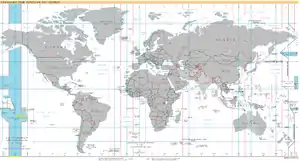UTC−10:00
UTC−10:00 is an identifier for a time offset from UTC of −10:00. This time is used in Hawaii, Alaska, French Polynesia, and the Cook Islands.[1]
| UTC−10:00 | |
|---|---|
| Time zone | |
 World map with the time zone highlighted | |
| UTC offset | |
| UTC | UTC−10:00 |
| Current time | |
| 06:31, 26 October 2023 UTC−10:00 [refresh] | |
| Central meridian | |
| 150 degrees W | |
| Date-time group | |
| W | |

UTC−10:00: blue (December), orange (June), yellow (year-round), light blue (sea areas)
As standard time (year-round)
Principal cities: Honolulu, Avarua, Papeete, Fa'a'ā
Polynesia
 France
France
 French Polynesia
French Polynesia
- Society Islands
- Tuamotus
- Disappointment Islands
- Duke of Gloucester Islands
- Far East Tuamotu Group
- Hao Group
- Hikeru Group
- King George Islands
- Palliser Islands
- Raeffsky Islands
- Gambier Islands
- Outer Gambier Group
- Acteon Group
- Austral Islands
- Tupua'i Islands
- Bass Islands
 New Zealand
New Zealand
 United States (Hawaii–Aleutian Time Zone)
United States (Hawaii–Aleutian Time Zone)
As standard time (Northern Hemisphere winter)
North America
Historical changes
- Kiribati
- Line Islands – including Kiritimati (Christmas Island) advanced 24 hours (to UTC+14:00) to the eastern hemisphere side of the International Date Line by skipping December 31, 1994.
- Samoa – Time in Samoa advanced 24 hours (to UTC+14:00) to the eastern hemisphere side of the International Date Line by skipping December 30, 2011.
References
- "Time Zone Abbreviations: CKT". Archived from the original on 2019-12-16. Retrieved 2015-02-16.
This article is issued from Wikipedia. The text is licensed under Creative Commons - Attribution - Sharealike. Additional terms may apply for the media files.